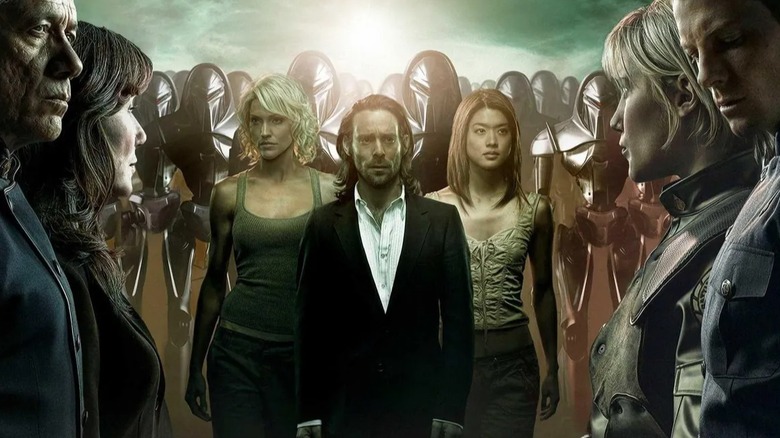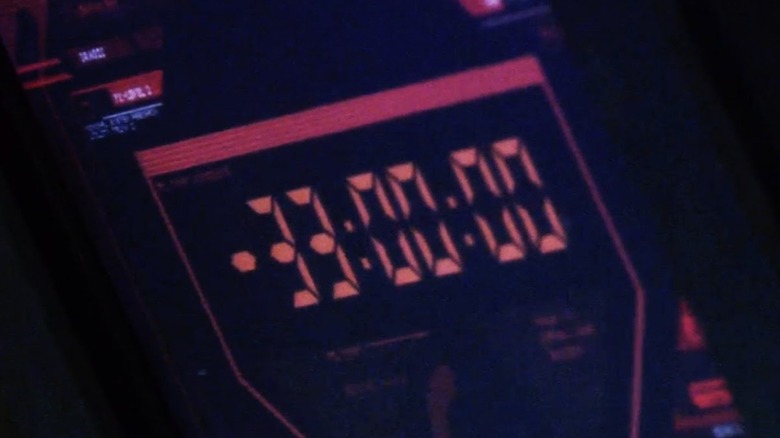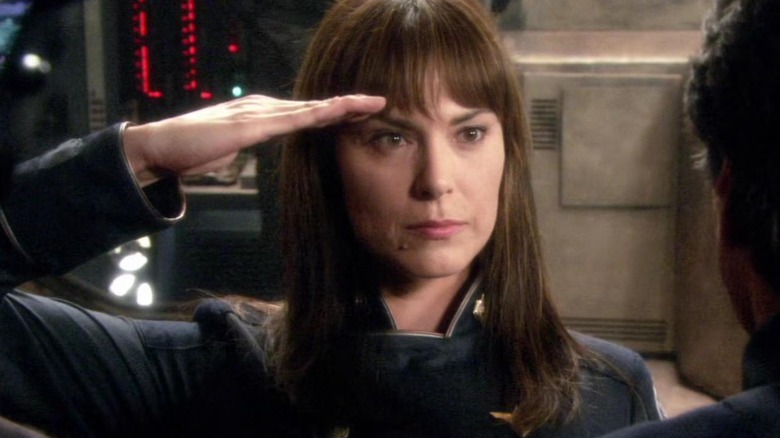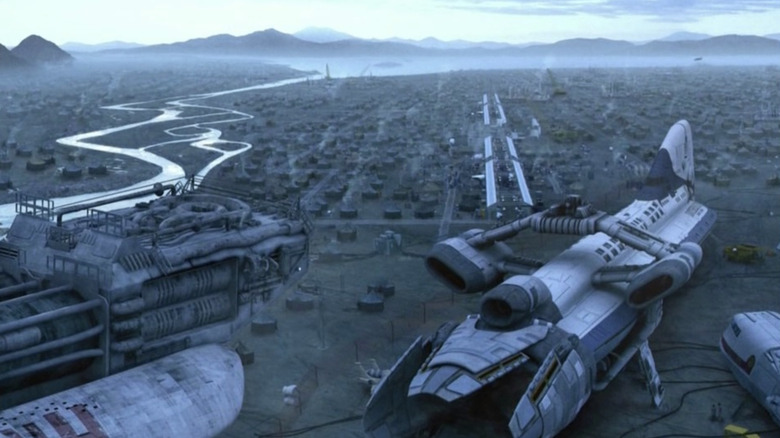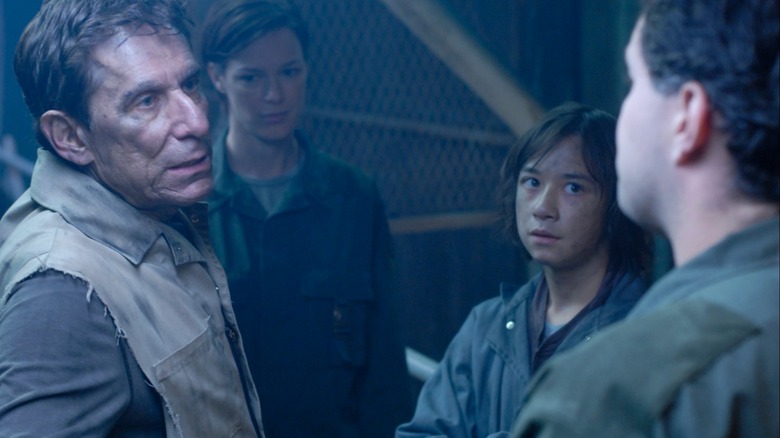5 Essential Battlestar Galactica Episodes Everyone Needs To Watch At Least Once
We may receive a commission on purchases made from links.
Created by Glen A. Larson in the wake of "Star Wars," "Battlestar Galactica" debuted on television in 1978. In the far reaches of space lie the "12 colonies of man," 12 planets named after the zodiac (Caprica, Tauron, etc.) that host a civilization of humans ... that is, until the colonies are destroyed by the robotic Cylons. The warship Galactica, with a fleet of civilian ships following it, sets out to find the fabled 13th colony: Earth.
The original "Galactica" burned bright for one season and then went out. A short-lived revival, "Galactica 1980," didn't take off.
But by the turn of the millennium, there was renewed interest in the series. Rather than picking up the original series, though, the powers that be opted for a fresh start. The reimagined "Battlestar Galactica" was developed by David Eick and prolific "Star Trek" writer Ronald D. Moore (who wanted to write things he couldn't on "Trek"). It took the same basic concept of the original series, but cut away the cheesiness. It ran for four seasons on Syfy and garnered substantial acclaim for its maturity, political relevance, bold storytelling, characterization, and acting.
For a lot of people (myself included), the reimagining is always what they'll think of first when they hear "Battlestar Galactica." (For more recent sci-fi, I'd also argue that "Andor" is tonally closer to "Battlestar" than it is to most other "Star Wars" media.) The four seasons of "Battlestar Galactica" have some peaks and valleys, but when it's great, which it often was, it was great. But even if you can't commit to the full journey, there are still a few "Battlestar Galactica" episodes you owe it to yourself to watch.
The Battlestar Galactica Mini-Series
This is where it all starts. "Battlestar Galactica" debuted not as a conventional TV series, but as a two episode mini-series (each episode runs 90 minutes long). The episode hits the same beats as the first episode of the original "Galactica," "Saga of a Star World." The 12 colonies of man exist, the Cylons attack and destroy them, and the Galactica survives and flees to find a new home.
The opening scene of the series, though, sets up how different this iteration will be from the original. In the original, the Cylons were alien invaders, whereas this time, "the Cylons were created by man." That turns the conflict into creator vs. created, which is much more potent and rich. The Cylons have evolved, too, and become more human than ever. They've literally taken on human form, and believe in a creator higher than mankind: the one true God.
The mini-series introduces all the primary characters the audience will keep following for the rest of the series: Galactica's Commanding Officer William Adama (Edward James Olmos), President Laura Roslin (Mary McDonnell), Adama's son Lee/Apollo (Jamie Bamber), hotshot pilot Kara Thrace/Starbuck (Katee Sackhoff), and scientist Gaius Baltar (James Callis), the one who inadvertently gave the Cylons the means to destroy the 12 colonies.
To understand and appreciate the characters and conflict of "Battlestar Galactica," you have to start here. Thankfully, the mini-series remains a wonderful introduction to both.
33 (season 1, episode 1)
With the mini-series serving as the effective pilot, "Battlestar Galactica" went on hiatus for about a year and had to win back audiences when it became a proper TV series. To say it came out strong is an understatement. "33," the "Battlestar Galactica" season 1 premiere, is about as perfect an episode and mission statement as can be.
Every 33 minutes, Cylon ships appear and attack the fleet, forcing them to "jump" (teleport across the cosmos) away. The episode begins in media res; when it opens, the fleet has been dodging the Cylons this way for more than five days. The mini-series established who these characters are, and now the very next episode wastes no time putting them under a stress test.
The tension of the chase culminates in the third act when one of the civilian ships, the Olympic Carrier, disappears after a jump only to reappear later. Suspecting the ship is what the Cylons were using to track the fleet, and the possibility it's being sent in now for a kamikaze attack, Adama and Roslin order Apollo and Starbuck to shoot it down.
"33" shows the unforgiving stakes of "Battlestar Galactica." The fleet is in a constant, painful battle for survival and there aren't going to be any convenient outs for difficult decisions (most of the time, at least). The loss of the Olympic Carrier isn't just a tragedy because the heroes had to kill their own people, but because of how few people they have left. With less than 50,000 human survivors, every single life is utterly precious.
That's why the episode's ending, where Roslin learns the first baby has been born on the fleet, is an utterly perfect note of hope.
Pegasus (season 2, episode 10)
The prize for shortest-lived but most impactful "Battlestar Galactica" character has to go Admiral Helena Cain (Michelle Forbes, one of the "Star Trek" alums that appears on "Galactica"), commander of the Battlestar Pegasus.
In "Pegasus," Galactica and the fleet discover that another human ship survived the Cylon attack, that ship being the titular Pegasus. This is one of the very rare times that the reimagining directly adapted an episode of the original; the '78 Galactica came across Cain (Lloyd Bridges) and the Pegasus in the two-part episode "The Living Legend."
That there are more survivors is an explosion of joy for both ships. The opening minutes of the episode are a celebration ... and then it all goes downhill, because sometimes the greatest enemy can come from within. Cain is what Adama would have become without Roslin to temper him; she's a ruthless dictator and encourages a violent, elitist attitude among her crew. Worse, she outranks Adama and the Pegasus outclasses Galactica, making our heroes the definite underdogs; seeing the Old Man pushed down the chain of command is startling.
There's a "Star Trek" cliche about the bureaucratic admiral coming in and getting in the captain's way. "Pegasus" takes that and amps up the drama. The episode ends in a stand-off between Galactica and Pegasus that threatens to erupt into a shooting match. It's impossible to decide who's the greatest star of the episode's closing moments: Olmos, Forbes, or composer Bear McCreary. What I do know for sure is that once "Pegasus" ends on that cliffhanger, you'll have no choice but to watch the subsequent two-parter "Resurrection Ship" ASAP.
The New Caprica arc (season 2, episodes 19-20 and season 3, episodes 1-5)
Yes, I'm cheating here by including multiple episodes, but New Caprica is an uncontested high point for "Battlestar Galactica," and you can't really single out one episode over the other.
In the "Battlestar Galactica" season 2 finale "Lay Down Your Burdens," the fleet discovers a habitable planet hidden in a nebula. They decide to settle down there, and the series jumps ahead a year to when "New Caprica" is a full (though not thriving) settlement. Then the Cylons show up to invade, ending the season on a cliffhanger.
The first four episodes of "Battlestar Galactica" season 3 focus on the Cylon occupation of New Caprica and the resistance against it. The Cylons don't want to exterminate humanity anymore ... they want to "teach" their parents the proper way to live, by force if necessary (which it quickly becomes).
When I interviewed David Eick, he discussed how he and Moore noted the parallels between the premise of the series and the then-recent 9/11 terrorist attacks. Americans' feelings of fear, paranoia, and loss were written into "Battlestar," and that's no doubt one reason the show resonated. But the series was always cautious, too, about how those feelings can lead to more authoritarian leadership.
Continuing the 9/11 connection, the New Caprica arc — about an invading force "freeing" a population and failing to control them — represents the invasion of Iraq. You've got one guess which party is Americans in this allegory, and I'll give you a hint: It's not the humans!
The fifth episode of season 3, "Collaborators," is an epilogue to this arc. A "circle" of six people are chosen to judge the people who collaborated with the Cylon government. The episode tackles the questions of vigilante justice, and reinforced how on "Battlestar," wounds don't heal when one episode ends.
Dirty Hands (season 3, episode 16)
An essential standalone episode and showcase for the realism of "Battlestar Galactica" is season 3's "Dirty Hands." This episode focuses on Galen Tyrol (Aaron Douglas), the commander of Galactica's deckhands, as he realizes just how bleak and oppressive working conditions in the fleet have become. (The episode centers on a fuel refinery ship to drive the idea home.) The climax of "Dirty Hands" is Tyrol calling a strike for the fleet's laborers.
With "Dirty Hands," "Battlestar Galactica" examines the logistical realities of rebuilding a society after an apocalypse. There are now about 40,000 people left, so everyone has to contribute to the fleet. But the diversity of skills is creating a class system; if you were a factory worker or a farmer before the Colonies' destruction, then you're stuck being a factory worker or a farmer now, with no opportunity to change jobs because that's where your existing skills are the most valuable. During the episode, one of Tyrol's deckhands, Diana Seelix (Jennifer Halley), is denied a promotion to fighter pilot because of her "essential skills."
Before this, "Battlestar" has largely focused on the upper class of the fleet, i.e. military and civilian leadership. That underlines the episode's point: The blue-collars workers of the fleet literally live on different spaceships, so it's been easy to keep their toil out of sight, out of mind.
Tyrol's eyes are opened not just by the refinery workers' suffering (e.g. lost limbs to heavy machinery), but the possibility of this caste system getting enshrined. Mankind is searching for Earth, but they have no idea how long that'll take. Their last attempt at settling a planet ended in disaster. The fleet could be their way of life for generations, and as traditions go on for generations, it becomes harder to break them.
But in situations as dire as these, where not just comfort but survival of the species depends on people doing their jobs, is striking still a right? Or do circumstances make it an even more vital right, to ensure the future of the species is one you'd want your children to live in? Moreover, Galactica is a military ship, where disobedience constitutes mutiny. Where do you draw the line between military chain of command and labor rights?
"Battlestar Galactica" used its science-fiction premise to ask these sorts of questions, ones that less courageous shows wouldn't dare touch.
